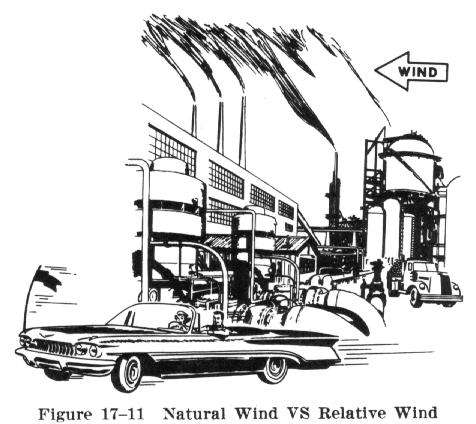| Relative Wind
Some pilots seem to find the term "relative wind" difficult to understand. Perhaps Figure 17-11 will help clarify it. The smoke from a factory moves because of natural wind. The pennant on a car traveling along the highway near the smoke stack flutters in a "relative" wind - that is, a flow of air which is created, not by the natural wind but by the auto's forward speed. The pennant on the car can show a "wind" whose direction is opposite to that of the smoke, though both are in the same natural wind. Relative wind is really not a wind at all in terms of our everyday understanding of the word. When dealing with principles of flight, it would no doubt be more accurate and descriptive to simply call it "the wind of flight," since it is the direction of airflow with respect to the wing as it moves through the air. If a wing is moving forward but settling downward, the relative wind is moving backward and upward. 
Relative wind can be created by the motion of a body through the air, the motion of air past a stationary body, or the combined motions of the air and the body. For example, an airplane in flight creates relative wind by virtue of its motion. Likewise, an airplane parked on the ramp with a mass of air flowing over its surfaces is subject to relative wind. Also, on a takeoff roll, an airplane is subject to a relative wind which is the resultant of two motions - that of the aircraft along the ground and that of the moving mass of air. It is for this reason that birds and airplanes, when given a choice, take off directly into the wind - so that the relative wind flowing along the wings will be greatest and provide as much lift as possible. When airborne, the actual flightpath of the airplane determines the direction of the relative wind. An understanding of the relative wind concept is fundamental to understanding "angle of attack."
|
